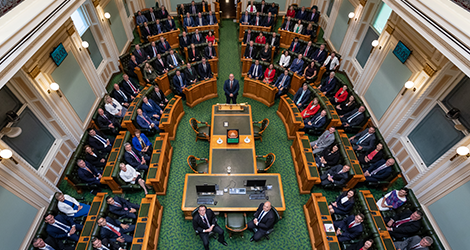I begin by acknowledging the traditional owners of the land on which we meet and I pay my respects to their elders past, present and emerging.
Thank you for the invitation this evening – and for the contribution you make to our nation every day.
The industries, businesses and workers represented in this room have played such an important role in dealing with the global challenges that have confronted our economy and our people over the past three years.
And your efforts are every bit as important to seizing the opportunities ahead of Australia in the next three years and beyond.
This is why I have always valued our constructive engagement.
Because even if we sometimes bring different perspectives to the public debate, we all share the same objective, founded on the same understanding.
We know that building Australia’s future depends on building a stronger, more competitive, more resilient and more productive economy.
An economy that creates wealth and opportunity, one that encourages innovation, attracts investment and rewards hard work.
That’s our Government’s vision but it can’t be realised by government alone.
We recognise that just as good jobs and fair wages depend on successful businesses, national prosperity depends on the engine room of private enterprise and the growth that private capital drives.
That’s why our Government has focused on providing business with the incentives, opportunity and certainty to invest: in new energy, new projects, new technology and new markets.
Of course, none of this work occurs in a vacuum.
Australia has faced the same fundamental challenges as every other advanced economy.
Global inflation has put pressure on the cost of living – and the cost of doing business.
The worst of this is behind us, with headline inflation down to 2.4 per cent.
But we know there is still work to do – and we know there will be new challenges to face.
The floods we’ve seen in Queensland are a reminder of the devastating toll natural disasters inflict on people and communities.
They also carry significant economic costs.
And as an outward looking economy, engaged in the world, global turbulence affects Australia.
Distance is no barrier to uncertainty, isolation is no answer – calm and constructive engagement is the way through, navigating differences diplomatically.
Australia is a great trading nation and a strong supporter of the free and fair trade that one in four Australian jobs depends on.
And our Government will always back Australian jobs and Australia’s interests, in strengthening ties with our old and trusted friends, restoring trade with vital partners and seeking out new markets and new opportunities.
I have a phone call scheduled with President Trump and I’m looking forward to talking with him again.
Australia has had a trade surplus with the United States going back to the Truman Administration.
And just as our alliance contributes to peace and security across the Indo-Pacific, our close economic ties have always delivered benefits for both our nations.
The reality we deal with in Australia is that the global economic and political environment is always changing.
So it’s no use waiting for the moment when all is quiet in the world.
Instead you have to invest in the skills and technology and energy, the infrastructure and the relationships that enable you to do more than just respond to change.
You can anticipate it, help shape it and make it work for people.
I’m realistic about the challenges we might face – and I’m optimistic about Australia’s capacity to meet them.
Because as we begin 2025, inflation is falling, real wages are rising.
Consumer confidence is picking up.
Over 1.1 million jobs have been created.
Including 47,000 additional jobs in manufacturing.
And last financial year saw the highest level of business investment in over a decade.
Another reason I’m optimistic about what’s ahead of us, is because I remember where we’ve come from.
Think back to where we were, three years ago.
The most dire skills crisis in 50 years.
A national energy grid on the brink, 10 years behind the world on renewables.
A broken migration system.
Our relationships with our neighbours in the Pacific and our largest trading partner in China at a low point.
A budget deficit of $78 billion.
From our first day in Government, we’ve been focused on clearing this mess away and laying the foundations to build something stronger and better.
So that Australia is prepared for the next challenge the world throws at us – and poised to seize the opportunities the world holds for us.
That’s what building Australia’s future is about.
Building the skills and capacity of our people: Free TAFE, new support for apprentices and new investments in the care economy.
Building and upgrading the roads, ports and homes that support growth, bring jobs to communities and boost productivity.
Clearing away old barriers to productivity growth – like the nearly 500 nuisance tariffs we abolished last year.
Building the new drivers of productivity – merger reform, modernising competition policy, taking the next steps to universal child care and finishing the NBN with fibre, not copper.
Australia has always been good at new technology – both creating it and embracing it.
We want to make sure that Australian workers and Australian businesses have the tools and skills to unlock the benefits of Artificial Intelligence and automation.
Because getting this right can add $600 billion to our economy by 2030.
And we’re encouraging the states to get moving on productivity too – with a new ³Ô¹ÏÍøÕ¾ Productivity Fund.
This is about helping with the cost of living by reducing the burden of regulation, everything from speeding up housing approvals and construction to boosting competition in the supermarket sector.
And just as the best way to make housing more affordable is to build more homes more quickly, the best way to make power more affordable is to bring more energy online, sooner.
Building the renewables, firmed by gas, that represent the only practical pathway to secure and affordable energy – now and into the future.
Because there is no industry anywhere in Australia that can afford to push pause and wait 20 years for a nuclear reactor.
Waiting until the 2040s to replace coal fired power stations retiring in the 2020s and 2030s only guarantees energy insecurity and job losses.
At its core, the Liberals’ nuclear plan means delay when Australia needs urgency.
It requires hundreds of billions of dollars in taxpayer money, because there’s not a single investor who wants to touch it.
And it’s designed for a smaller and narrower economy, with fewer jobs.
The basis of our opponents’ plan is the idea that Australia will use 40 per cent less energy than the Australian Energy Market Operator has found will be needed.
Whereas our plan is about ensuring you have access to the reliable, affordable power you need to grow your businesses and grow our economy.
Record levels of investment are flowing into renewables right now, bringing renewables up to 46 per cent of the grid in the last quarter.
Not taxpayer dollars, private capital.
Since we were elected, 15 gigawatts of solar and wind have come online.
Enough to power 5.5 million households.
Another 20 gigawatts of large-scale renewables is under construction, or about to be.
25,000 homes are adding rooftop solar every month.
That speaks for the level of catching-up that Australia has to do.
It also shows the power of certainty.
The clear 2030 target our Government set, something AiG endorsed from the outset.
The Safeguard Mechanism that rewards your businesses for upgrading to new technology.
And the Capacity Investment Scheme – driving tens of billions of dollars in investment from companies that recognise the scale of this opportunity.
From my first day in this job, when I flew to Japan to join a meeting of the Quad, I’ve made it a priority to build – and rebuild – Australia’s international relationships.
We are re-engaged in the Pacific, because we are back among the nations taking climate change seriously.
We have stabilised our relationship with China, clearing away more than $20 billion in trade impediments that were hurting our farmers, growers and producers.
And – in partnership with the Australian Industry Group and the direct participation of so many business leaders in this room – we are bringing a new comprehensive approach to our investment in India and South East Asia.
Because the fastest growing region of the world in human history has to be a bigger part of our future growth strategy.
And as we strive for greater diversity in who we trade with – we must also aim for greater diversity in what we trade.
The high-quality products and services we can offer the world.
This is why we are building-up our industrial base.
Our ³Ô¹ÏÍøÕ¾ Reconstruction Fund is driving new investment across medical science, technology and mining.
Working together with our Future Made in Australia plan, which is all about Australian workers and Australian companies making things here.
Production Tax Credits to incentivise value-adding in clean energy and critical minerals.
New investments in green metals, securing the future of our aluminium industry and the tens of thousands of jobs it supports.
Streamlining approvals to get new projects up and running faster.
Backing local jobs and skills, so projects in northern Australia and the regions in particular, deliver for communities.
And a more rigorous and more efficient framework for international investment.
This is a plan for economic sovereignty, as well as economic resilience.
Making sure that the next big disruption to the global supply chain – whatever form it takes – doesn’t leave Australia stranded.
But this is also about securing the next generation of economic growth.
Making the most of all our nation’s strengths: clean energy, critical minerals, skilled workers and the space we have, a continent to call our own.
A stable, open democracy on the threshold of the biggest markets in the world, with diaspora communities that give us a family connection to every nation on earth.
This an unmatched combination – and if we act now, we can make it an unbeatable one.
We can do much more than weather the next global storm.
We can compete and succeed, on our terms.
We can build a new comparative advantage for ourselves in refining, processing and manufacturing.
And we can position Australia as the destination of choice for new data centres and all the jobs they represent, all the innovation they drive.
This is the future we can build together, on the foundations we have laid.
Where our economy is stronger because your industries are stronger.
Growing because your businesses are growing.
More productive because we’re investing in the skills, education and training of the Australian people.
More resilient and diversified, because our Future Made in Australia plan means you can make new products for new markets.
And more secure because industry can count on clean energy.
This stronger, more productive, more resilient Australia is closer now than at any time in the past decade.
Let us continue to engage with each other, listen to each other, work with each other so we can seize this opportunity – and secure it – for the decades ahead.








